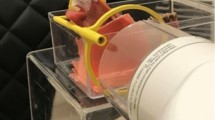Abstract
An experimental study was conducted to classify the influence of trabecular architecture and cortical shell thickness on the mechanical properties using a bone surrogate. Thirty-six rectangular prisms and 18 vertebral-shaped specimens were fabricated with fused deposition modelling (FDM) as a bone surrogate with controlled structural characteristics (cortical wall thickness, strut spacing, strut angle and strut orientation). The apparent density of the FDM specimens was evaluated using quantitative computed tomography (QCT) imaging and related to the apparent elastic modulus measured with compression testing. The effects of the structural parameters on the apparent elastic modulus were analysed using analysis of variance (ANOVA). The results obtained corroborate that the structural parameters have a significant effect on the apparent mechanical properties of the bulk material. The cortical shell thickness was found to have more influence than trabecular architecture. Therefore, accurate modelling of the cortical shell thickness should be considered more important than trabecular architecture in development of bone finite element models and bone surrogates.




Similar content being viewed by others
References
Andresen R, Werner HJ, Schober HC (1998) Contribution of the cortical shell of vertebrae to mechanical behaviour of the lumbar vertebrae with implications for predicting fracture risk. Br J Radiol 71:759–765
ASTM (1996) Standard test method for compressive properties of rigid plastics. ASTM International, West Conshohocken, PA, pp 76–82
Bryce R, Aspden RM, Wytch R (1995) Stiffening effects of cortical bone on vertebral cancellous bone in situ. Spine (Phila Pa 1976) 20:999–1003
Buckley JM, Loo K, Motherway J (2007) Comparison of quantitative computed tomography-based measures in predicting vertebral compressive strength. Bone 40:767–774
Crawford RP, Cann CE, Keaveny TM (2003) Finite element models predict in vitro vertebral body compressive strength better than quantitative computed tomography. Bone 33:744–750
Dai LY, Wang XY, Wang CG, Jiang LS, Xu HZ (2006) Bone mineral density of the thoracolumbar spine in relation to burst fractures: a quantitative computed tomography study. Eur Spine J 15:1817–1822
Dickerson CR, Saha S, Hotchkiss CE (2008) Relationships between densitometric and morphological parameters as measured by peripheral computed tomography and the compressive behavior of lumbar vertebral bodies from macaques (Macaca fascicularis). Spine (Phila Pa 1976) 33:366–372
Eswaran SK, Gupta A, Adams MF, Keaveny TM (2006) Cortical and trabecular load sharing in the human vertebral body. J Bone Miner Res 21:307–314
Helgason B, Perilli E, Schileo E, Taddei F, Brynjolfsson S, Viceconti M (2008) Mathematical relationships between bone density and mechanical properties: a literature review. Clin Biomech (Bristol, Avon) 23:135–146
Inui A, Itamoto K, Takuma T, Tsutsumi H, Tanigawa M, Hayasaki M, Taura Y, Mamba K (2004) Age-related changes of bone mineral density and microarchitecture in miniature pigs. J Vet Med Sci 66:599–609
Ito M, Nishida A, Koga A, Ikeda S, Shiraishi A, Uetani M, Hayashi K, Nakamura T (2002) Contribution of trabecular and cortical components to the mechanical properties of bone and their regulating parameters. Bone 31:351–358
Keller TS (1994) Predicting the compressive mechanical behavior of bone. J Biomech 27:1159–1168
Kopperdahl DL, Keaveny TM (1998) Yield strain behavior of trabecular bone. J Biomech 31:601–608
Liebschner MA, Kopperdahl DL, Rosenberg WS, Keaveny TM (2003) Finite element modeling of the human thoracolumbar spine. Spine 28:559–565
Mirzaei M, Zeinali A, Razmjoo A, Nazemi M (2009) On prediction of the strength levels and failure patterns of human vertebrae using quantitative computed tomography (QCT)-based finite element method. J Biomech 42:1584–1591
Montgomery D (2005) Design and analysis of experiments. John Wiley & Sons Inc, Hoboken, NJ, p 643
Morgan EF, Bayraktar HH, Keaveny TM (2003) Trabecular bone modulus-density relationships depend on anatomic site. J Biomech 36:897–904
Nicholson PH, Cheng XG, Lowet G, Boonen S, Davie MW, Dequeker J, Van der Perre G (1997) Structural and material mechanical properties of human vertebral cancellous bone. Med Eng Phys 19:729–737
Rho JY, Hobatho MC, Ashman RB (1995) Relations of mechanical properties to density and CT numbers in human bone. Med Eng Phys 17:347–355
Silva MJ, Keaveny TM, Hayes WC (1998) Computed tomography-based finite element analysis predicts failure loads and fracture patterns for vertebral sections. J Orthop Res 16:300–308
Acknowledgments
This research was funded in part by the Canadian Institutes of Health Research (CIHR), the Natural Science and Engineering Council (NSERC) and by the Canadian Foundation for Innovation (CFI). The authors would like to thank Mathieu Dansereau for his assistance in sample fabrication.
Author information
Authors and Affiliations
Corresponding author
Rights and permissions
About this article
Cite this article
Levasseur, A., Ploeg, HL. & Petit, Y. Comparison of the influences of structural characteristics on bulk mechanical behaviour: experimental study using a bone surrogate. Med Biol Eng Comput 50, 61–67 (2012). https://doi.org/10.1007/s11517-011-0763-x
Received:
Accepted:
Published:
Issue Date:
DOI: https://doi.org/10.1007/s11517-011-0763-x




